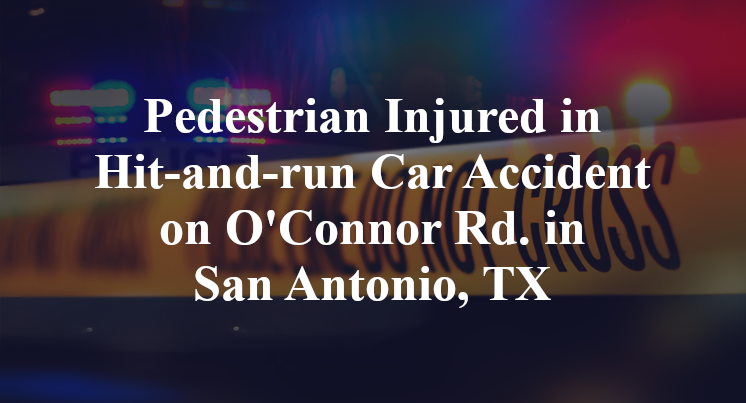Pedestrian Injured in Hit-and-run Car Accident on O’Connor Rd. in San Antonio, TX
Bexar County, TX — September 3, 2024, a man was injured due to a pedestrian versus hit-and-run car accident just after 10:30 p.m. along O'Connor Road.
According to authorities, the accident took place on O'Connor Road at the Larkdale Driver intersection

Details surrounding the accident remain scarce. Officials indicate that, for as yet unknown reasons, a 42-year-old man who had been on foot at the intersection was struck by a vehicle of unknown make of model that had been traveling southbound on O'Connor Road. He reportedly sustained critical injuries due to the collision and was transported to a local medical facility by EMS in order to receive immediate treatment. The vehicle allegedly fled the scene, the person(s) inside failing to stop and render aid of any sort to the victim. Additional information pertaining to this incident—including the identity of the victim—is not available at this point in time. The investigation is currently ongoing.
Commentary
When someone is struck and left behind in a hit-and-run, the physical wounds are just one part of the harm. What’s often missing is a clear picture of how it happened—and without that, there’s little chance of holding the right party accountable.
1. Did the authorities thoroughly investigate the crash?
With the driver fleeing the scene, it’s vital that investigators moved quickly to canvass the area for surveillance footage, traffic cameras, or eyewitness accounts. Did they collect physical evidence like broken vehicle parts, tire marks, or clothing debris? These details can help narrow down the type of vehicle involved. In cases like this, time is critical—and the quality of the investigation often hinges on whether responding officers had the resources and training to work quickly and thoroughly.
2. Has anyone looked into the possibility that a vehicle defect caused the crash?
Even in hit-and-run cases, it’s worth asking—could something have gone wrong mechanically that caused the driver to lose control or react too late? Did the vehicle's headlights fail? Was there an issue with brakes or steering? And if the vehicle is ever recovered, was there any evidence of a malfunction that might explain why the driver panicked or didn’t stop? These questions tend to get buried once blame shifts solely to the fleeing driver, but they still matter.
3. Has all the electronic data relating to the crash been collected?
Although the vehicle left the scene, there are other forms of data that can help. Were license plate readers or nearby surveillance systems active in the area? Has phone tower data been reviewed to identify devices traveling through that intersection around the time of the crash? If the vehicle is found, its onboard data could reveal speed, braking, and whether the driver ever tried to avoid the pedestrian. That kind of evidence often holds the key—but only if someone is looking for it.
In the chaos of a hit-and-run, the hardest part is what’s missing. But filling those gaps takes real effort—and a willingness to ask the questions that most people ignore.
Takeaways:
- Hit-and-run crashes demand urgent, resource-intensive investigation to preserve scene evidence.
- If the vehicle is found, its condition and systems must be inspected for possible defects.
- Camera footage and digital data from the area may reveal who fled—and what happened before impact.

*We appreciate your feedback and welcome anyone to comment on our blog entries, however all visitor blog comments must be approved by the site moderator prior to showing live on the site. By submitting a blog comment you acknowledge that your post may appear live on the site for any visitors to see, pending moderator approval. The operators of this site are not responsible for the accuracy or content of the comments made by site visitors. By submitting a comment, blog post, or email to this site you acknowledge that you may receive a response with regard to your questions or concerns. If you contact Grossman Law Offices using this online form, your message will not create an attorney-client relationship and will not necessarily be treated as privileged or confidential! You should not send sensitive or confidential information via the Internet. Since the Internet is not necessarily a secure environment, it is not possible to ensure that your message sent via the Internet might be kept secure and confidential. When you fill out a contact or comment form, send us an email directly, initiate a chat session or call us, you acknowledge we may use your contact information to communicate with you in the future for marketing purposes, but such marketing will always be done in an ethical way.